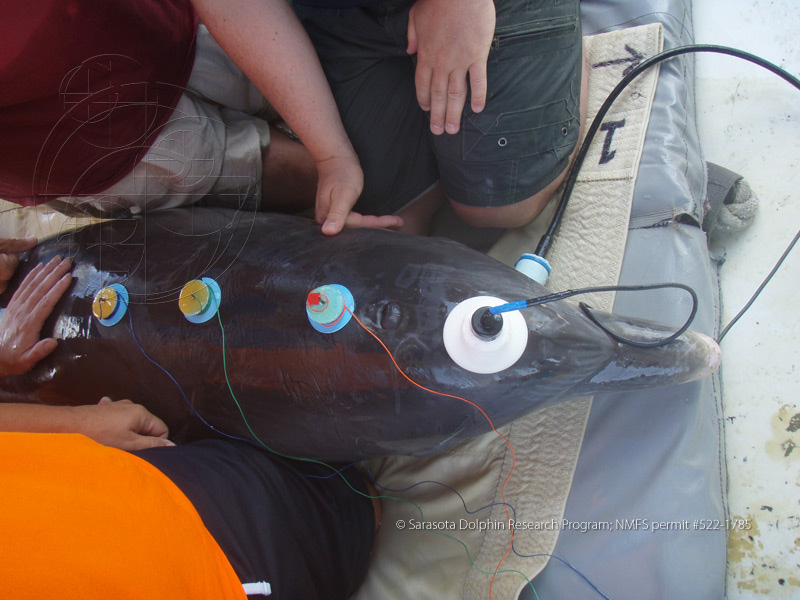
Researchers test dolphins’ hearing using using auditory evoked potentials, or AEPs. During testing, sensors are placed on an animal’s head to measure brain activity in response to a sound. This is the same way we test the hearing of human babies. This picture shows how the sensors are mounted to a dolphin using suction cups. Tests are briefly conducted and then the dolphins are released unharmed.
Testing Dolphin Hearing
Bottlenose dolphins can hear at frequencies from about 75 Hertz (Hz) to more than 150,000 Hz — well beyond the range of human hearing (20-20,000 Hz).
Because dolphins are exposed to a wide variety of both naturally-occurring and anthropogenic (human-caused) noise in their environment, we wanted to study whether these noises have negative effects on their hearing abilities. Hearing losses in these animals can be especially problematic because dolphins rely primarily on sound production and reception to navigate, find food, and to communicate with each other, especially in murky estuarine habitats such as Sarasota Bay.
An SDRP study measured the hearing abilities of bottlenose dolphins in Sarasota Bay using auditory evoked potential (AEP) procedures based on techniques used to measure hearing in human infants. Short duration tones of varying frequencies and sound levels were played to the dolphins using a jawphone (a speaker embedded in a suction cup and attached to the lower jaw of the animal).
The jawphone makes use of the fact that dolphins hear through their lower jaw, with sounds conducted to the ear through a fat channel associated with the jaw bone. Sensors in small suction cups placed on the dolphin’s head measured tiny electrical signals produced by the brain in response to the tones. The brain’s responses to the sounds were then analyzed to determine each dolphin’s hearing abilities.
In one study, we collected data from 5 females and 3 males, ages 3-31 years, during our annual assessment of the health of the Bay’s dolphins. Overall, we found that dolphins in Sarasota Bay do not exhibit increasing hearing losses with increasing age, nor are male dolphins more likely than female dolphins to have a hearing deficit.
We also did not find that the dolphins exhibited substantial hearing losses due to daily exposure to environmental noise, including anthropogenic sources of noise.




